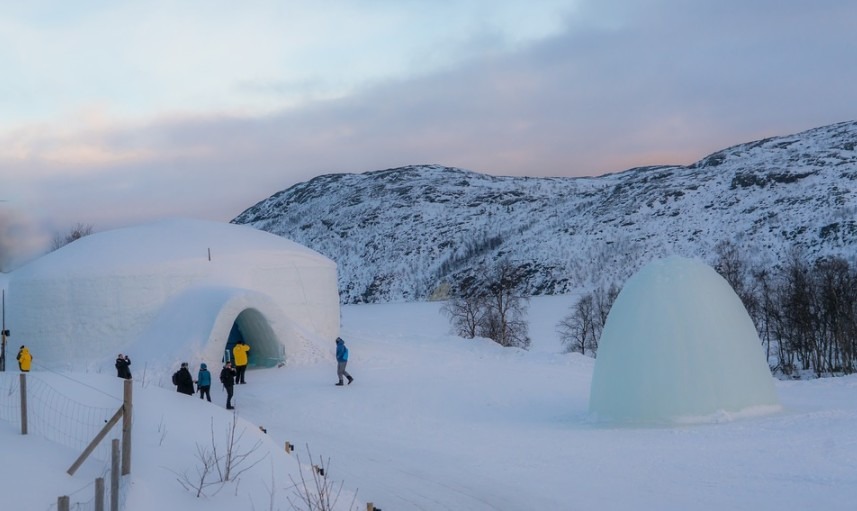What do you know about igloos, besides being a dome shape shelter?
Igloo is also called Aputiak. They are “snow huts,” a type of shelter built of snow, typically built when the snow is suitable. They serve as a temporary dwelling of the Canadian and Greenland Inuit or what we know as Eskimos.
The term igloo, iglu, is related to a town’s name Igluik, and an Inuit people called Iglulik, both located on the island of the same name.
A dome shape very compact hard blocks of snow make up an igloo. It is only utilized in the area between the Mackenzie River delta and Labrador as during summer; it is where the Inuit live in sealskin, or, more recently, cloth tents.
The vast Arctic is one of the most forbidding environments on the planet, but the Inuits could live there for about 5000 years. Do they have that extra-thick skins? Or cold-proof bodies? How can something cold, or rather an icy cold, keep you feel cozy and warm? How can an igloo made of snow give warm?
How are Igloos Built?
Igloos were typically about 3 to 3.5 m high and 3.5 to 4.5 m in diameter. They often housed a family in which larger sizes igloos could accommodate up to about 20 people. Hunters sometimes made smaller igloos — perhaps about 1.5 m high and 2 m in diameter — to shelter them through the night or when a storm comes.
In building an igloo, the builder uses a deep snowdrift of fine-grained, compact snow and cut into blocks using a snow knife made of whale bones, metals, or other tools to cut out large snow blocks.
The cut snow is in a rectangular block that measures 2 feet by 4 feet (60 cm by 120 cm) and 8 inches (20 cm) thick.
The first row of blocks is laid out in a circle on a flat stretch of snow. Then the blocks’ top surfaces are shaved off in a sloping angle to form the first rung of a spiral. More blocks are added to the spiral to draw it inward until it completes the dome, but except for a hole left at the top for ventilation. Loose snow fill the joints and crevices, and a clear piece of ice or seal intestine is inserted for a window.
To provide entry into the igloo, there are narrow passageways dug just below ground level. Snow blocks are also used as doors. The windows are either made of lake ice or a clear piece of gut skin from a seal. The is a hole at the entrance and the top of the igloo so that heat can escape. Once the construction is done, the builders will further fill in any gaps with snow to keep it warm on the inside.
How can the igloo provide warmth?
It seems it wouldn’t work. Snow is in itself icy and freezing, so how can it provide warmth to the body? Wouldn’t it melt eventually? How about the air that gets inside the igloo? There are many questions on how igloo can be a warm shelter for those living in the planet’s icy-cold regions.
Compared to compressed snow, ice isn’t an excellent insulator because ice is solid while snow is filled with tiny air pockets. About 95% of snow is air trapped inside small crystals. The heat gets trapped as the air can’t circulate very well inside the ice crystals.
Because the door of an igloo is at the bottom, with at least one right-angled piece of a tunnel to crawl through, the cold wind cannot blow directly into the living space.
The floor is not just similar to that of a tent. It is cut into terraces, which create an upper level for sleeping. The middle level is used for the fire, and the little hole cut into the top of the curved roof lets smoke from the fire escape safely. The lower level is used as a cold sink.
The heavy cold air that naturally falls is collected on the floor near the door, and it just stays there. The lighter warm air naturally rises and remains in the igloo parts that people use the most, including the sleeping area.
Outside temperature can be as cold as minus fifty degrees Fahrenheit, but it is as cozy as 19 to 61 degrees Fahrenheit indoors. It may not be as warm enough always, but a temperature difference is good, sometimes as much as seventy degrees warmer than the outdoors.
Related posts:
What does the inside of Eskimos’ igloo look like?
Why walking on ice is difficult? Why is ice slippery?
Does the Abominable Snowman (Yeti) Really Exist In The Himalayas?

